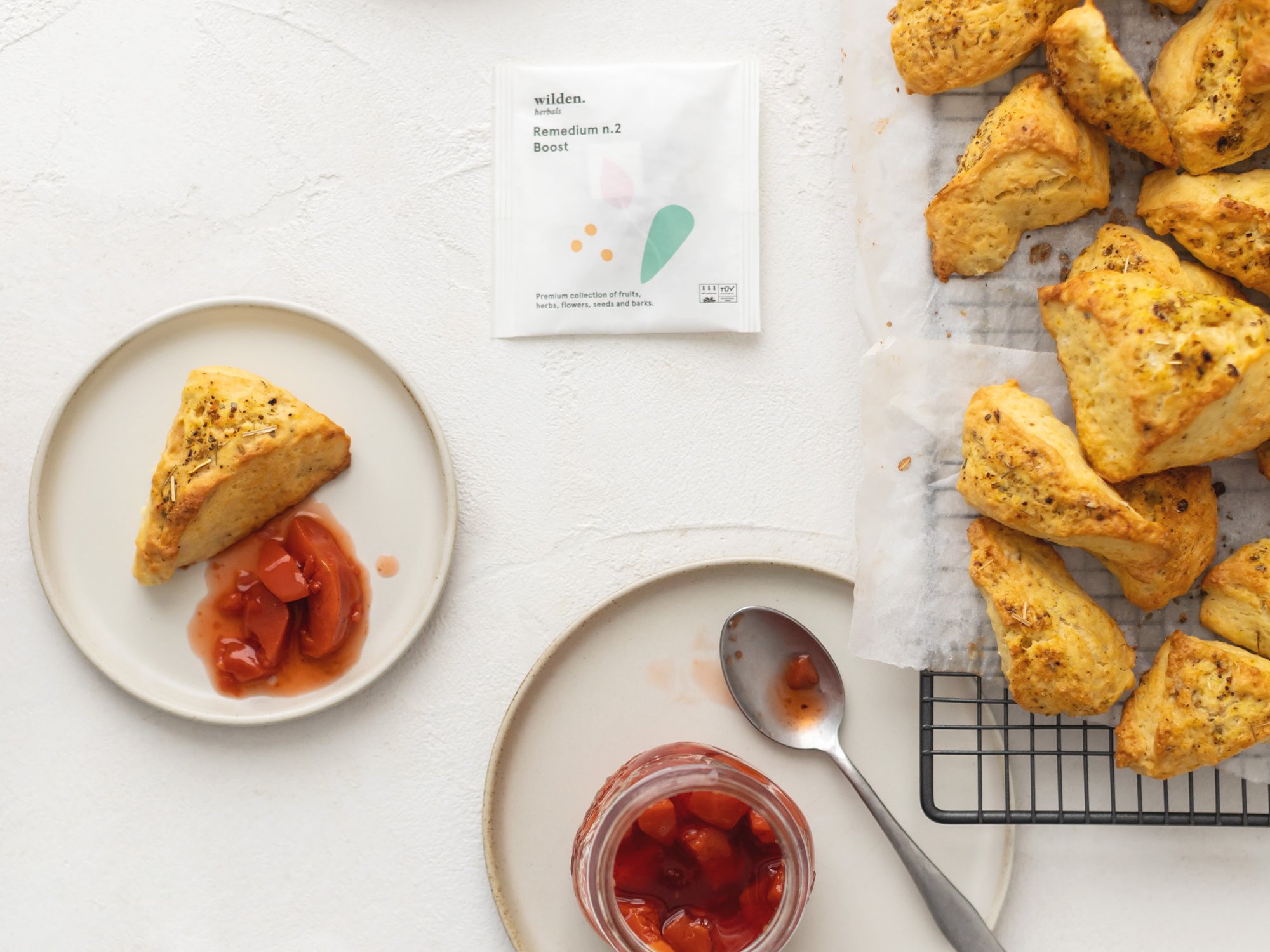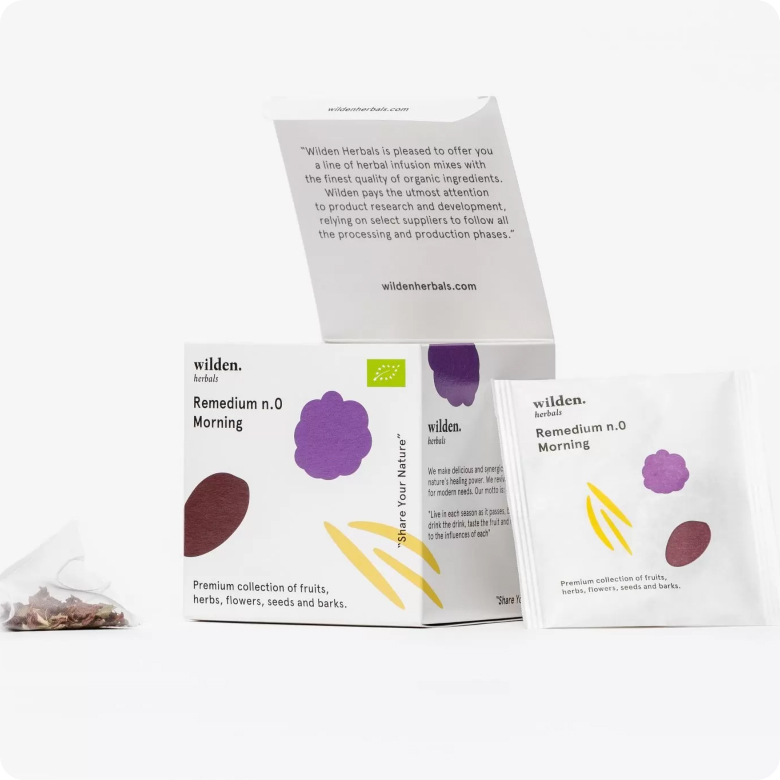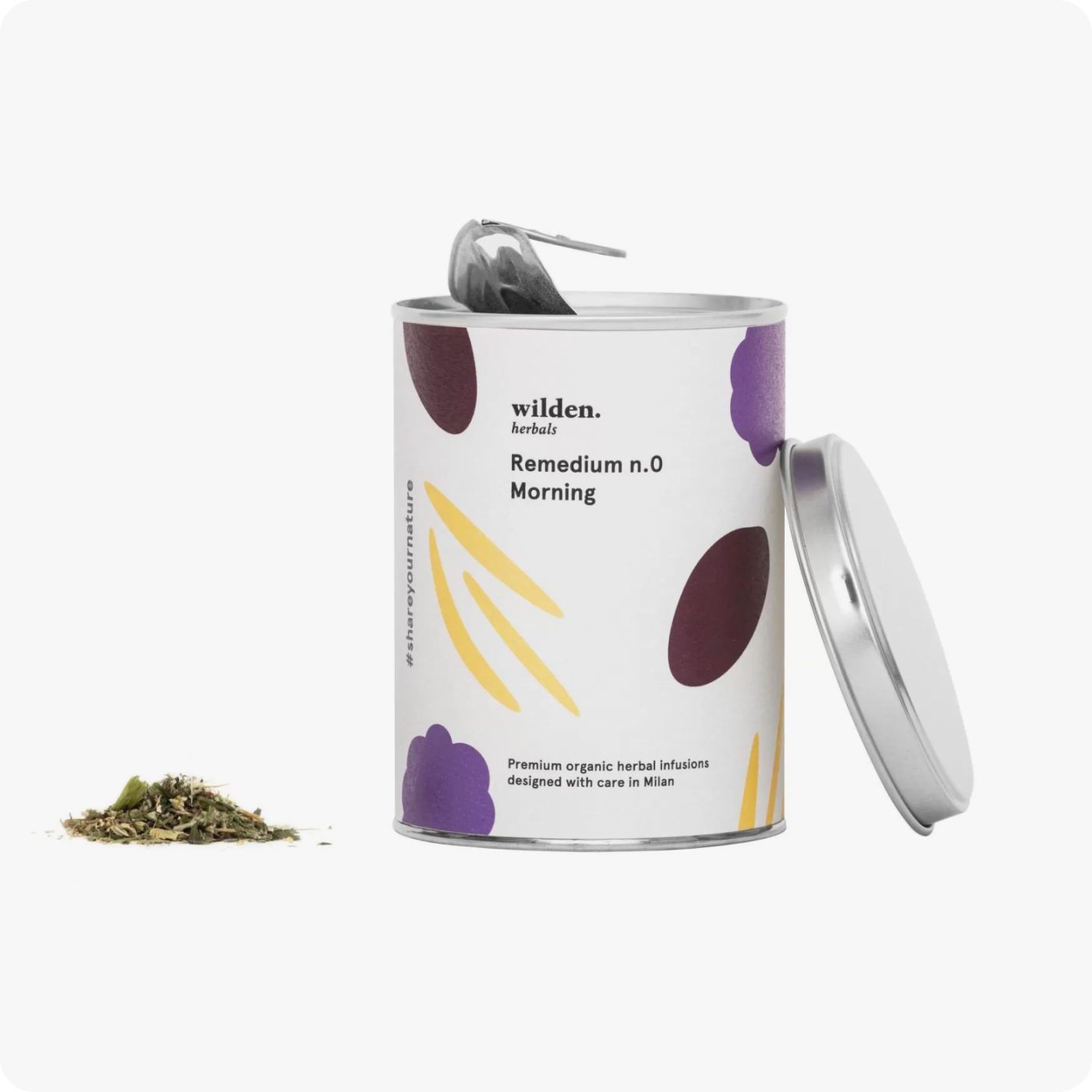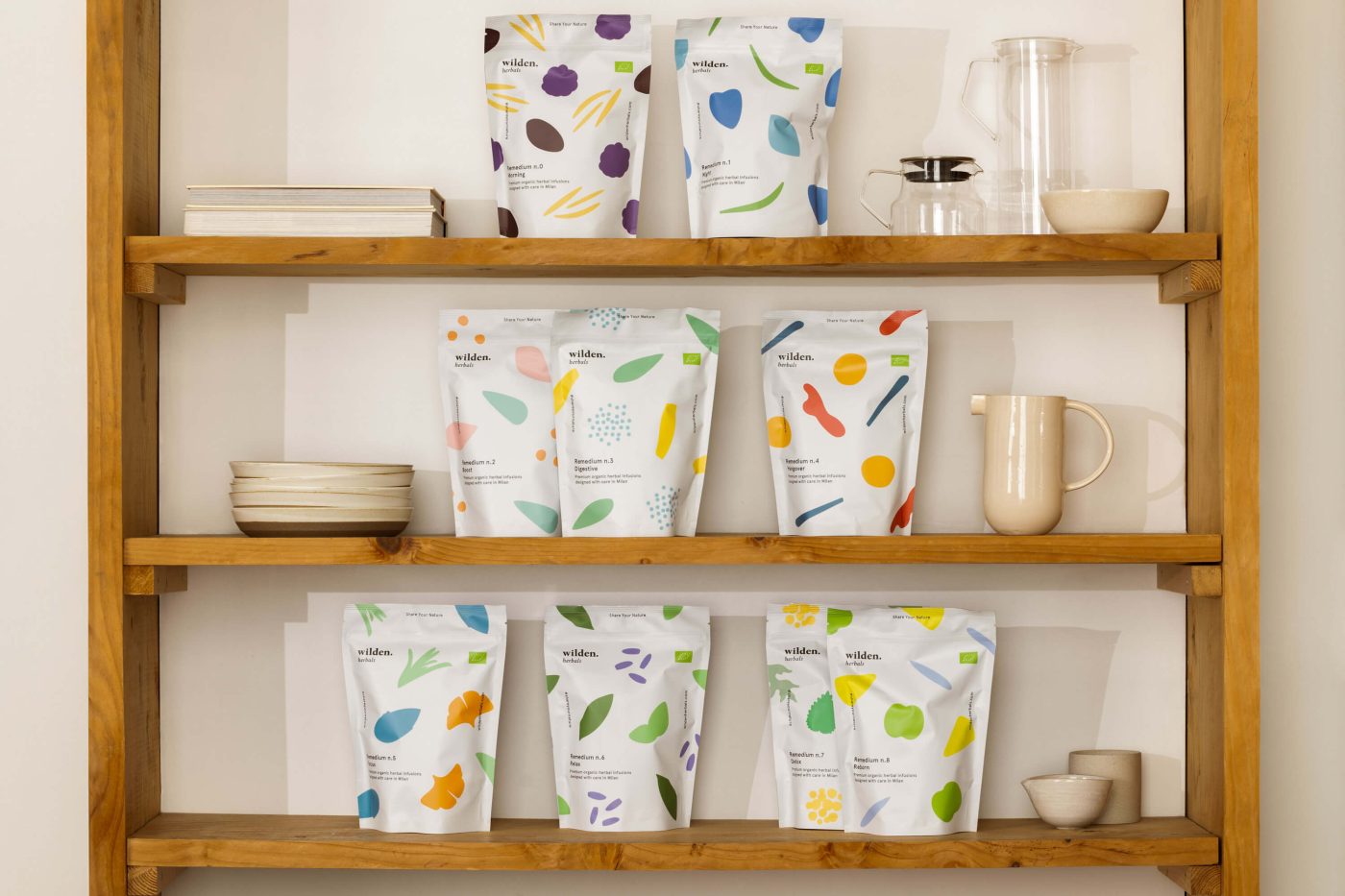Remedium No. 4 – Hangover
From composition to benefits, Wilden.herbals chronicles its herbal teas one by one on a journey to discover the power of plants.
Remedium No. 4 – Hangover is a complex recipe composed of 11 herbs specially selected and chosen to ensure a rejuvenating feeling and restart at our best, especially when we are in “Hangover.”
In this Remedium we find lemon, lemongrass and orange rich in Vitamin C and invigorating; mint, ginger and licorice that give the infusion its special fresh and fragrant flavor. Finally, black pepper and turmeric and mallow, gentian and chamomile, which provide the balance among all the herbs to promote a synergistic action in favor of the liver, stomach and intestines, releasing a marked tonic and energetic sensation.
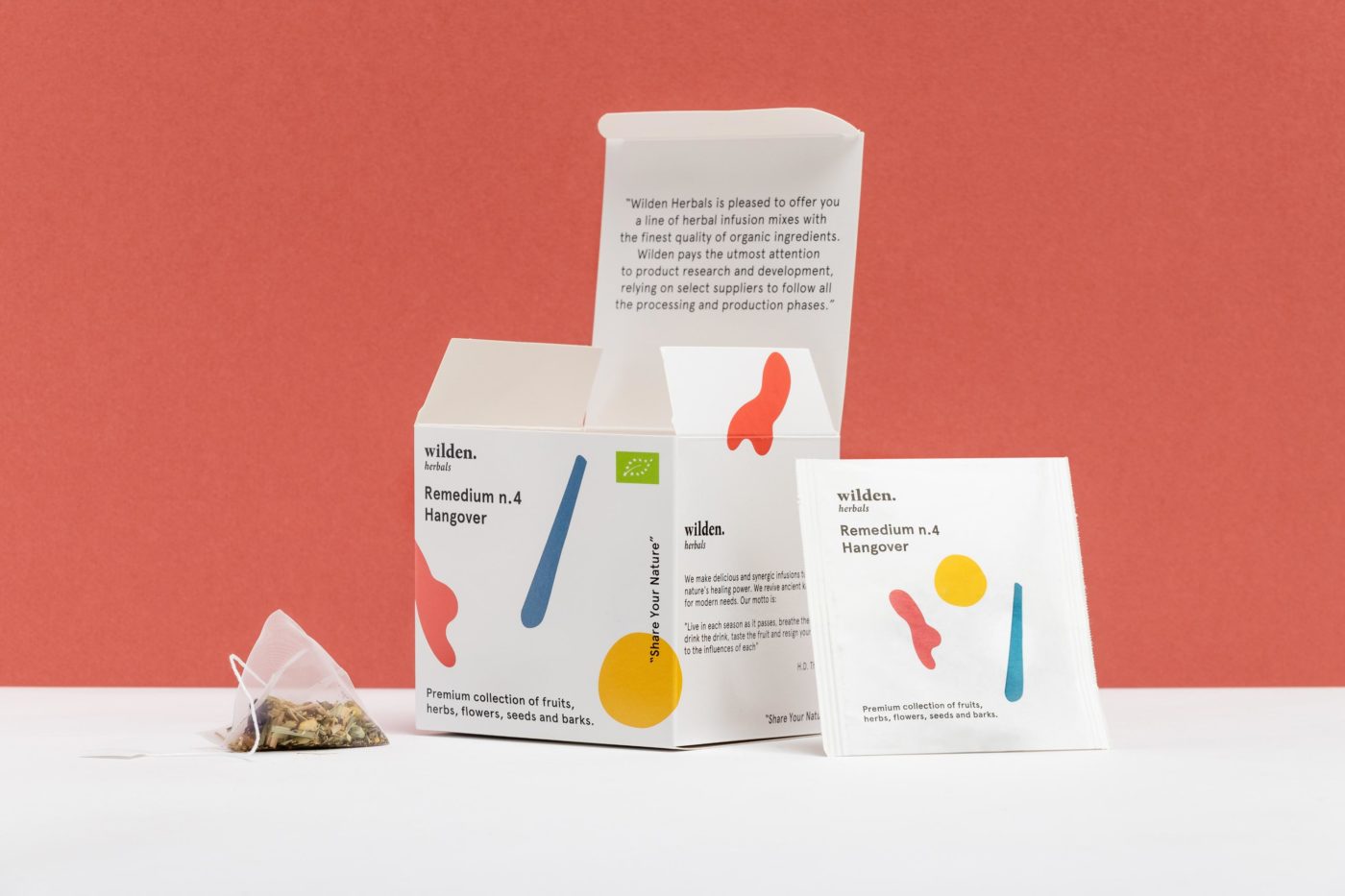
Sweet orange, Citrus sinensis
Chamomile, Matricaria chamomilla
Fennel, Foeniculum dulce
Gentian, Gentianae luteae
Lemon, Citrus limon
Lemongrass, Cymbopogon citratus
Mallow, Malva officinalis
Mint, Mentha x piperita
Black pepper, Piper nigrum
Turmeric, Curcuma longa
Ginger, Zingiber officinale

This is the composition per 100g:
Sweet orange, Citrus sinensis
Orange peel is used for its properties as well as for its pleasant aroma. The active ingredients in the essential oil (hesperidin and limonin) in addition to a large amount of vitamin C and minerals such as iron and calcium are useful for strengthening our bodies, especially in the winter seasons. In addition, sweet orange, with its fragrant and thirst-quenching aroma, has aperitif, digestive and antispasmodic properties, useful for stomach pains.
Chamomile, Matricaria chamomilla
Chamomile flowers are used to prepare infusions with sedative, calming and anti-inflammatory virtues. The presence of flavanoids and coumarins provides the plant with antispasmodic properties that produce muscle relaxation. Precisely because of its muscle relaxant virtues, chamomile is used as a useful sedative in cases of nervous tension, stress, and anxiety. Its anti-inflammatory effects also help against inflammation, promote digestion and relieve heartburn.
Fennel, Foeniculum dulce
Fennel, commonly known as Wild Fennel, is a Mediterranean plant with Middle Eastern origins and renowned aromatic and phytotherapeutic properties. The seeds, rich in anethole, potassium, and vitamin C, are loved for their carminative properties that promote elimination and reduction of intestinal gas; among their many merits, digestive, stimulant, and diuretic properties stand out. Using the seeds in infusion releases the aromas and releases its active ingredients.

Gentian, Gentianae luteae
Gentian is a rare and very ancient plant, typical of the mountainous regions of Southern Europe , famous for its nutritional and phytotherapeutic benefits. The plant is rich in active ingredients and alkaloids that stimulate appetite and aid digestion by promoting fatty acid production. In classical tradition it is used against fever and colds or as an antiseptic. The dried root is prepared by infusion, either in water or alcohol, and has a typical bitter but very fragrant taste.
Lemon, Citrus limon, Paraguay
Lemon, the fruit of Citrus limon, has uncertain origins but has been appreciated throughout the world for millennia and boasts wide therapeutic as well as dietary use. Lemon is rich in vitamin C and mineral salts and has a wide range of therapeutic and nutritional properties, bringing great benefits to the circulation, digestive and respiratory systems. The infused peel releases all its aromas, enhancing its digestive and astringent properties.
Lemongrass, Cymbopogon citratus
This plant is an aromatic concentrate of essential nutrients and pharmacological properties with many health benefits. The components responsible for the lemon fragrance (limonene, citral) have antifungal and antibacterial properties. It is used in Ayurvedic medicine to strengthen the immune system and treat flu symptoms: cough, nasal congestion, fever, exhaustion, and headache. It has antioxidant and diuretic properties that help cleanse the body of toxins.
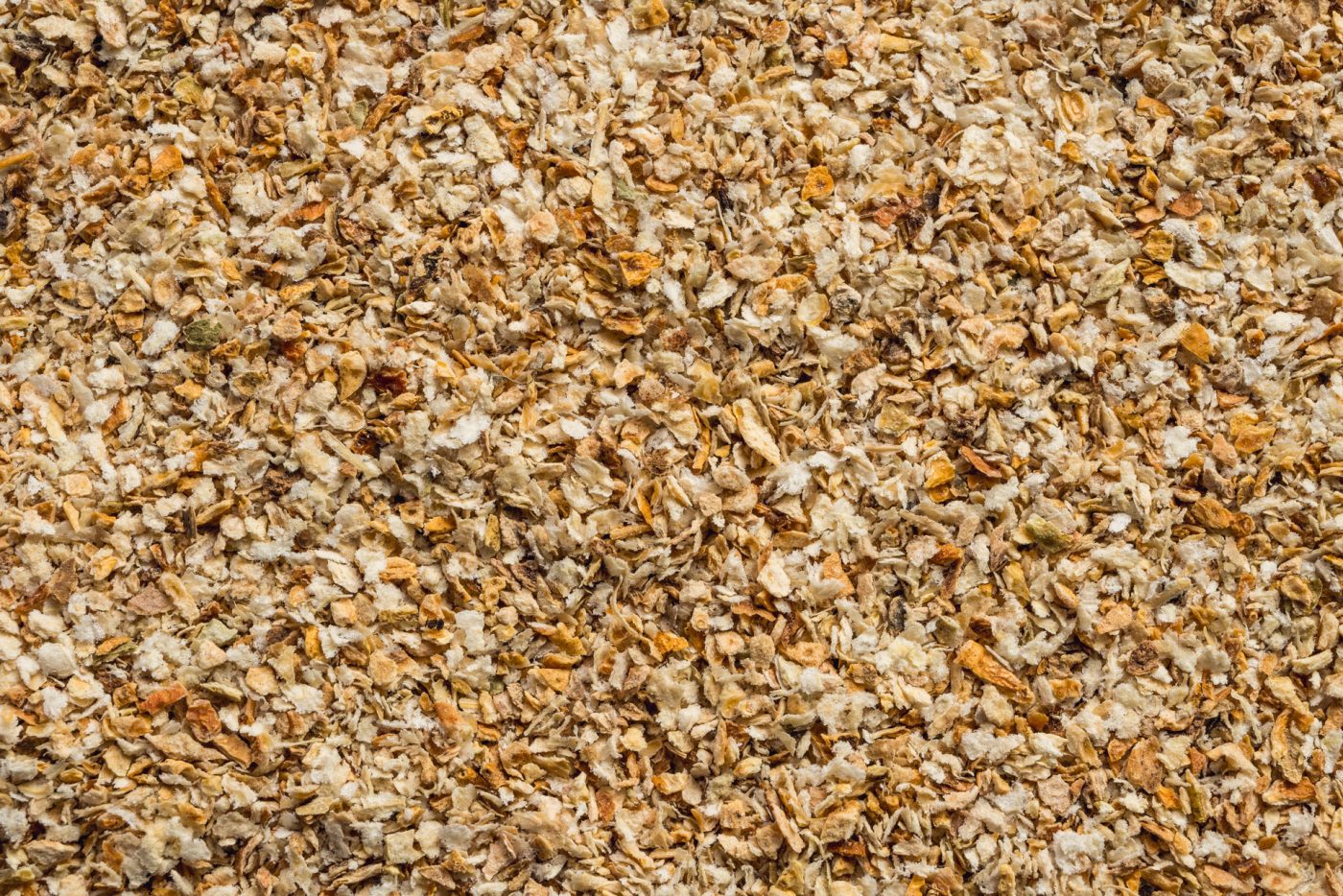
Mallow, Malva officinalis
Mallow has been known for its emollient virtues since ancient times. Its name comes from the Latin mollire, meaning “able to soften,” and the Greek malachè, “to make soft.” The flowers and leaves are rich in mucilage, which coats mucous membranes with a viscous layer that protects them from irritants. Hence its emollient and anti-inflammatory properties. Mallow herbal tea is recommended as a soothing and relaxing drink to be taken in the evening to relax and sleep better. It also has digestive virtues and is useful in cases of stomach acidity.
Mint, Mentha x piperita
Peppermint, a variety of the genus Mentha, is a plant of European origin now cultivated and appreciated worldwide; rich in enzymes and flavonoids, it owes most of its beneficial properties to Menthol. Mint, already appreciated in ancient times by the Egyptians and Greeks, promotes respiration, invigorates the nervous system, aids digestion, protects the liver and intestines, and alleviates symptoms of flu, colds and diarrhea. The infused leaves release all the aromas and essences with their characteristic flavor, which promotes proper digestion, releasing a pleasant sensation of freshness.

Black pepper, Piper nigrum
For centuries, the fruit of this plant represented an extremely valuable bargaining chip. In Ayurvedic medicine, black pepper is a powerful remedy for stimulating metabolism and eliminating toxins. It has antioxidant properties (piperine) and is good for “colds,” flu, coughs, nasal congestion and fever. In addition, pepper facilitates the absorption of nutrients and combined with turmeric, as in this mixture, increases their bioavailability by up to 2000%.
Turmeric, Curcuma longa
Turmeric is a spice with a warm yellow-orange color and penetrating aroma, widely used in Indian cooking. The name is derived from Sanskrit “kum-kuma” and Arabic “kour-koum,” meaning saffron, because of its similarity in color to the precious spice. Widely used in Ayurvedic medicine as a depurative, turmeric is recommended to improve liver health, eliminate excess cholesterol and facilitate digestion. It also has anti-inflammatory, antiviral, antibacterial, antifungal and antioxidant properties.

Ginger, Zingiber officinale
The rhizome of this plant native to the tropical forests of India and Southeast Asia is widely used both as a spice and as a traditional remedy. The active ingredients it contains (gingerols) make ginger an effective antioxidant against inflammation, congestion, coughs, colds and fevers. In traditional Chinese medicine it performs an action called “dispersing the cold” accumulated in the body.


Hangover Bread 
Hangover Meringue 
Remedium No. 4 – Hangover is a vitamin concentrate that helps get the bad days back on track. Its blend of organic plants and spices has an energetic, invigorating and stimulating function that will give you the right boost.
© 2021 Wilden.herbals – Contents are the property of Wilden.herbals S.r.l., reproduction is prohibited
Sources:
- Wagner, H., & Ulrich-Merzenich, G. (2013). Evidence and rational based research on Chinese drugs. Wien: Springer.
- Phytotherapy, rational use of plant drugs, F. Capasso G. Grandolini A.A. Izzo Springer
- Bates SH, Jones RB, Bailey CJ, Insulin-like effect of pinitol, British Journal of Pharmacology 2000; 130(8): 1944-1948
- Kamara BI, et al, Polyphenols from honeybush tea, Journal Agricultural Food Chemistry 2003; 51(13): 3874-3879
- Kenneth M. Klemow, Andrew Bartlow and Justin Crawford, Herbal Medicine: Biomolecular and Clinical Aspects.
- Barnes Joan, Anderson A. Linda, Phillipson David J. Herbal Medicines, Pharmaceutical Press 2007.
- Blumenthal M., Goldberg A., Brinckmann J (Ed). Expanded Commission E Monographs, American Botanical Council and Integrative Medicine Communications 2000.
- European Scientific Cooperative on Phytotherapy (Ed). Melissea folium, ESCOP Monographs on the Medicinal Uses of Plants Drugs, Centre for Complementary Health Studies, Université d’Exeter 1996.
- Franchomme P. et Pénoël D. L’aromathérapie exactement. Encyclopédie de l’utilisation thérapeutique des huiles essentielles. (Aromatherapy exactly. Eencyclopedia of the therapeutic use of essential oils).
- Roger Jollois Éditeur 1990 Pizzorno JE Jr, Murray Michael T (Ed). Textbook of Natural Medicine, Churchill Livingstone 2006
- Organisation mondiale de la santé (World Health Organization). WHO monographs on selected medicinal plants, vol. 2, Suisse, 2002.

